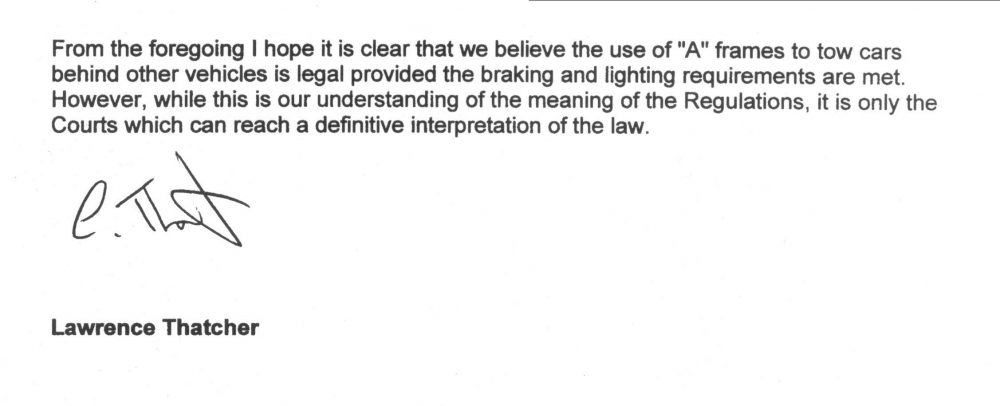Aframe Legislation



Transcribed:
Towing with “A” Frames
Thank you for your letter dated 2 January 2004 relating to the use of “A”frames for the purpose of towing following an earlier communication from my colleague Mike Lowe.
When an “A” frame is attached to a vehicle (e.g a motor car) and towed by a motor vehicle (e.g motorhome) we believe the “A” frame and car become a single unit and as such are classified in legislation as a trailer. Consequently, the car and A-frame are required to meet the technical requirements for trailers when used on the road in Great Britain. These requirements are contained within the Road Vehicles (Construction and Use) Regulations 1986 (SI 1986/1078) as amended (C&U) and the Road Vehicles Lighting Regulations 1989 (SI 1989/ 1796) AS AMENDED (RVLR).
Trailers having a combined axle mass not exceeding 750kg are not required to have brakes fitted. However, if the trailer (Regardless of mass) is fitted with a braking system, that system must be capable of being operated. The regulations do not include design constraints on how this should be achieved but, for example, it could be met by direct linking of the trailer brakes to the brake system of the towing vehicle or by automatic inertia (overrun) operation via the towing hitch. Inertia systems can only be used for trailers with up to a combined axle mass of 3500kg.
Construction and Use Regulation 15 sets out the braking requirements – including minimum braking efficiencies for trailer brakes. Subject to certain age exemptions, the regulation requires the system to comply with the construction, fitting and performance requirements of European Community Directives or the equivalent UNECE Regulation. The relevant European Community Directive 71/320/EEC along with it’s various amending Directives have culminated in a consolidated version – 98/12/EC. The corresponding UNECE Regulation is NO. 13.
In addition, C&U regulation 18 requires braking systems to be in good and efficient working order. While it is for the courts to interpret the law, we feel that this provision means compliance with the requirements of the EU Directive or UNECE Regulation.
It should be possible for the braking requirements for trailers given in the Directives to be met by the car braking system providing that when the brakes on the towing vehicle are applied, those on the trailer (e.g car + “A” frame) are also applied. If the brakes of the towing vehicle do not directly operate the trailer brakes inertia (overrun) system is acceptable as an alternative to operate the trailer (e.g car + “A” frame) brakes, If the braking system has power assistance (i.e servo or full power) it is likely that this assistance will be required during towing to meet the required braking efficiencies. From October the 1st 1988 the inertia braking system is required to allow the trailer to be reversed with the towing vehicle without imposing a sustained drag and such devices used for this purpose must engage and disengage automatically.
Other provisions for Regulation 15 and Regulation 86A of C&U require the fitting and use of a secondary coupling system in which the trailer is stopped automatically if the main coupling separates whilst the combination is in motion. Alternatively, in the case of trailers up to a maximum mass of 1500kg, the drawbar must be prevented from touching the ground and the trailer retains some residual steering.
Whilst being towed, trailers are subject to the relevant requirements given in RVLR, including the use of triangular red reflectors. There would be further requirements for the display of the appropriate number plate, etc.
You mention specifically in your letter the information Mr Lowe provided as parts of his reply to your initial enquiry. I understand the Mr Lowe explained when you spoke in late December that he would provide the STATUS document as background information in my absence and in good faith. You are wrong to conclude that we endorse the STATUS document. I can confirm that STATUS is not connected to the Department of Transport, but we have placed research contracts with them and as a supplier of expert advice on certain areas of vehicle technology.
We do not supply copies of legislation, but I have included some information on various sources where they can be obtained. If you would like to purchase printed copies od Statutory Instruments these are available from TSO:
The Stationary Office Tel: 0870 600 5522
PO Box 29 Fax: 0870 600 5533
St Crispins Email: book.orders@tso.co.uk
Duke Street Online ordering: www.tso.co.uk/bookshop
Norwich NR3 1GN
Alternatively you can consult “The Encyclopaedia of Road Traffic Law and Practice” published by Sweet and Maxwell. This publication is updated regularly and is available in most city reference libraries.
EU Directives can be found at:
http://europa.eu.int/eur-lex/en/search_lif.html
UN- ECE Regulations can be found at:
http://www.unece.org/trans/main/wp29/wp29regs.html
For the foregoing I hope it is clear that we believe that use of “A” frames to tow cars behind other vehicles is legal provided the braking and lighting requirements are met. However, while this is our understanding of the meaning of the Regulations, it is only the Courts which can reach definitive interpretation of the law.

